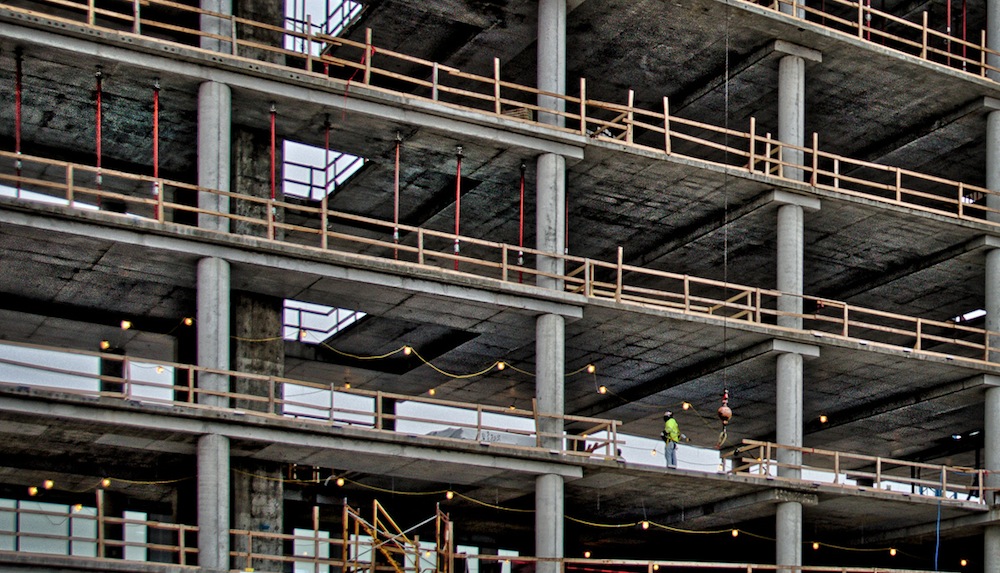Nonresidential construction spending dipped for a second consecutive month, falling 0.4% on a monthly basis in December, according to analysis of U.S. Census Bureau data released by Associated Builders and Contractors (ABC). Nonresidential construction spending totaled $681.2 billion on a seasonally adjusted, annualized basis. November's nonresidential construction spending estimate was revised lower by 0.6% to $683.7 billion.
For a second consecutive month, 12 of 16 nonresidential subsectors experienced spending decreases on a monthly basis. Private nonresidential spending dipped 2.1% for the month, while public sector spending expanded 2.2%.
"December's estimate is a bit unnerving not only because it represents a second consecutive month of spending decline, but also because unusually warm temperatures should have helped to translate into better spending performance," ABC Chief Economist Anirban Basu said. "A number of leading indicators suggest that nonresidential construction spending performance will remain choppy moving forward, both for the broader economy and the nation's nonresidential construction segment, including the Baltic Dry Index, the Conference Board's Index of Leading Economic Indicators and the Architecture Billings Index.
"This is not to suggest that the nonresidential recovery will end in the near term," Basu said. "Most firms continue to report healthy backlog and hiring remains aggressive, implying that many firms are staffing up in order to perform on forthcoming contractual opportunities. However, private credit is beginning to tighten and becoming more expensive. Consumer delinquencies are edging higher and corporate bond defaults have been climbing. Accordingly, many contractors may experience a slowdown in backlog accumulation in 2016, with the 2017-2018 economic outlook remaining decidedly murky."
Only four of 16 nonresidential construction sectors experienced spending increases in December on a monthly basis:
- Spending in the highway and street category expanded by 9.6% on a monthly basis and 11.7% on a yearly basis.
- Communication-related spending increased 4% month over month and 37.2% year over year.
- Sewage and waste disposal-related spending expanded 1.3% for the month, but fell 9.7% from the same time last year.
- Spending in the amusement and recreation category climbed 0.5% on a monthly basis and 9.2% on a year-over-year basis.
Spending in 12 of the nonresidential construction subsectors fell in December on a monthly basis:
- Spending in the power category fell 0.3% from November 2015, but is 7.6% higher than in December 2014.
- Commercial-related construction spending fell 0.6% for the month and 3.2% for the year.
- Educational-related construction spending fell 0.8% on a monthly basis, but expanded 10% on a yearly basis.
- Transportation-related spending fell 0.8% month over month, but expanded 2.3% year over year.
- Lodging-related spending was down 1.3% for the month, but is up 29.1% on a year-ago basis.
- Spending in the office category fell 1.8% from November 2015, but is up 16.6% from December 2014.
- Water supply-related spending fell 2.9% on a monthly basis and 6.6% on a yearly basis.
- Health care-related spending fell 3.2% month over month, but is up 0.4% year over year.
- Spending in the religious category fell 4.1% for the month and 1.7% for the year.
- Public safety-related spending declined 4.6% for the month and 7.4% for the year.
- Manufacturing-related spending fell 7.2% from November 2015, but is 19.6% higher than in December 2014.
- Conservation and development-related spending declined 9.9% on a monthly basis and is 8% lower on a yearly basis.
Related Stories
| Aug 11, 2010
Installation work begins on Minnesota's largest green roof
Installation of the 2.5 acre green roof vegetation on the City-owned Target Center begins today. Over the course of two days a 165 ton crane will hoist five truckloads of plant material, which includes 900 rolls of pre-grown vegetated mats of sedum and native plants for installation on top of the arena's main roof.
| Aug 11, 2010
Jacobs, Holder Construction top BD+C's ranking of the nation's 50 largest industrial building contractors
A ranking of the Top 50 Industrial Contractors based on Building Design+Construction's 2009 Giants 300 survey. For more Giants 300 rankings, visit http://www.BDCnetwork.com/Giants
| Aug 11, 2010
AASHE releases annual review of sustainability in higher education
The Association for the Advancement of Sustainability in Higher Education (AASHE) has announced the release of AASHE Digest 2008, which documents the continued rapid growth of campus sustainability in the U.S. and Canada. The 356-page report, available as a free download on the AASHE website, includes over 1,350 stories that appeared in the weekly AASHE Bulletin last year.
| Aug 11, 2010
HNTB, Arup, Walter P Moore among SMPS National Marketing Communications Awards winners
The Society for Marketing Professional Services (SMPS) is pleased to announce the 2009 recipients of the 32nd Annual National Marketing Communications Awards (MCA). This annual competition is the longest-standing, most prestigious awards program recognizing excellence in marketing and communications by professional services firms in the design and building industry.
| Aug 11, 2010
New book provides energy efficiency guidance for hotels
Recommendations on achieving 30% energy savings over minimum code requirements are contained in the newly published Advanced Energy Design Guide for Highway Lodging. The energy savings guidance for design of new hotels provides a first step toward achieving a net-zero-energy building.
| Aug 11, 2010
Turner Building Cost Index dips nearly 4% in second quarter 2009
Turner Construction Company announced that the second quarter 2009 Turner Building Cost Index, which measures nonresidential building construction costs in the U.S., has decreased 3.35% from the first quarter 2009 and is 8.92% lower than its peak in the second quarter of 2008. The Turner Building Cost Index number for second quarter 2009 is 837.







